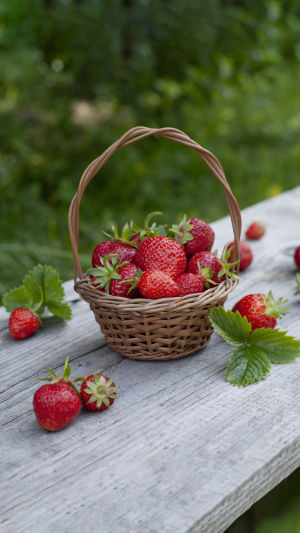Strawberries are a beloved summer fruit known for their bright red color, juicy texture, and irresistible sweetness.
Whether sliced over your morning cereal or dipped in chocolate for a treat, strawberries offer a burst of flavor that few fruits can match.
But have you ever wondered how strawberries get their signature flavor and vibrant color? Behind this delicious berry is a complex science that blends genetics, environmental factors, and chemistry. Let's dive into the sweet science of strawberries and discover what makes them so irresistible.
<h3>The Secret to Strawberry Flavor</h3>
The flavor of a strawberry is the result of a delicate balance between sugars, acids, and aromatic compounds. The sweetness comes primarily from natural sugars, like glucose and fructose, while the tangy taste comes from organic acids, particularly citric and malic acid. When these elements are in perfect harmony, you get that signature sweet-tart taste.
But the flavor doesn't stop there—strawberries also contain over 300 volatile compounds, which give them their unique aroma. These are the molecules that hit your nose when you bite into a ripe strawberry, creating that fresh, fruity smell. Some of the key compounds include esters, aldehydes, and terpenes, which contribute to the fruity, floral, and slightly earthy notes you experience when eating a strawberry.
Interestingly, the flavor of strawberries can vary depending on the variety and growing conditions. For instance, some strawberries are bred for intense sweetness, while others have a stronger tartness. Environmental factors such as temperature, sunlight, and soil quality also play a role in determining how flavorful a strawberry will be.
Strawberries grown in warmer climates tend to have more sugar content, making them sweeter, while those grown in cooler climates may develop more acid, giving them a tangier taste.
How To Pick Strawberries!
Video by Wilson's Orchard & Farm
<h3>How Strawberries Get Their Color</h3>
The vibrant red color of a strawberry is more than just a visual cue for ripeness; it's also a sign of its health benefits. Strawberries get their red hue from natural pigments called anthocyanins, which are antioxidants that help protect the plant from UV radiation and other environmental stresses. These pigments are part of the flavonoid family and are responsible for the red, purple, and blue colors in many fruits and vegetables.
As strawberries ripen, the concentration of anthocyanins increases, turning the fruit from white or pale green to a deep, rich red. This change in color is not just about aesthetics—it also indicates that the fruit is becoming sweeter and more flavorful. The more intense the red color, the more anthocyanins the strawberry contains, which can also translate to higher levels of antioxidants for those eating the fruit.
<h3>The Role of Genetics in Flavor and Color</h3>
Behind every delicious strawberry is a carefully crafted genetic blueprint. Over the years, strawberry breeders have worked to create varieties with better flavor, color, size, and shelf life. Some strawberries are bred specifically for sweetness, while others are developed to withstand long shipping times or to resist disease.
The wild ancestors of modern strawberries were smaller and less sweet, but through selective breeding, today's strawberries have been optimized for flavor and size. In fact, many strawberries on the market today are hybrids of different varieties, combining the best traits of each to create a more flavorful, vibrant fruit. That's why some strawberries are sweeter and juicier than others, even if they look the same on the outside.
<h3>How to Pick the Perfect Strawberry</h3>
Choosing the best strawberry at the grocery store or farmer's market is easier than you might think. First, look for berries that have a deep, even red color. This indicates that they are fully ripe and will be at their sweetest. Avoid strawberries with white or green patches, as they are likely underripe and won't have as much flavor.
Next, give the berries a sniff. A ripe strawberry should have a sweet, fragrant aroma. If the berries don't smell like much, they probably won't taste like much either. Size isn't necessarily an indicator of flavor, so don't be fooled by giant strawberries. Sometimes, the smaller ones pack more of a flavor punch.
Finally, check for firmness. Strawberries should feel plump and firm but not hard. Soft, mushy berries are likely overripe and may spoil quickly. When picking strawberries from the vine, gently tug on the stem. A ripe strawberry should come off easily with a slight twist.
<h3>Why Fresh is Best</h3>
Strawberries are best enjoyed fresh because they are highly perishable. Once picked, strawberries stop ripening, so they won't get any sweeter after they're harvested. For the best flavor, eat strawberries within a day or two of buying them. If you can, store them in the fridge, but let them come to room temperature before eating—this enhances their natural sweetness.
Freezing strawberries is also an option if you want to enjoy them later. However, frozen strawberries tend to lose some of their texture and flavor compared to fresh ones. Still, they're great for smoothies, baking, or making homemade jams.
<h3>The Perfect Blend of Nature and Science</h3>
Strawberries are a perfect example of how nature and science come together to create something truly delightful. Their flavor and color result from a complex combination of genetics, environmental factors, and chemistry.
Whether you prefer your strawberries sweet, tart, or somewhere in between, understanding the science behind them makes enjoying this favorite fruit even more satisfying.





